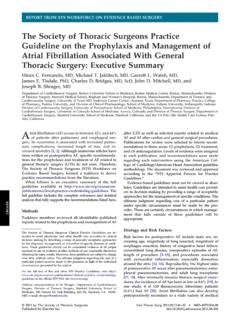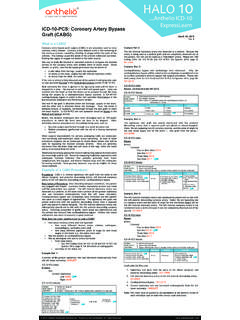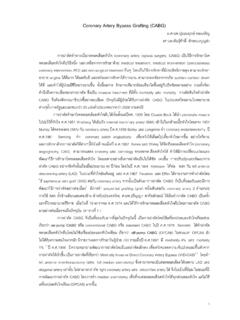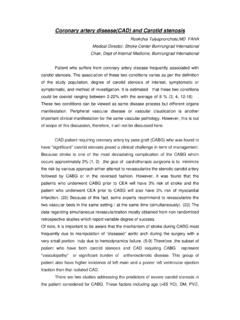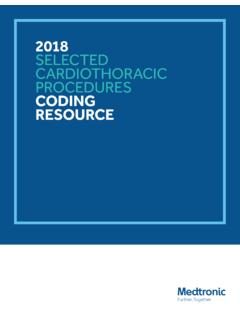Transcription of The Society of Thoracic Surgeons Clinical Practice ...
1 The Society of Thoracic Surgeons Clinical PracticeGuidelines on Arterial Conduits for CoronaryArtery bypass GraftingGabriel S. Aldea, MD, Faisal G. Bakaeen, MD, Jay Pal, MD, PhD, Stephen Fremes, MD,Stuart J. Head, MD, PhD, Joseph Sabik, MD, Todd Rosengart, MD,A. Pieter Kappetein, MD, PhD, Vinod H. Thourani, MD, Scott Firestone, MS, andJohn D. Mitchell, MDDivision of Cardiothoracic Surgery, University of Washington School of Medicine, Seattle, Washington; Department of CardiovascularSurgery, Texas Heart Institute, Houston, Texas; Schulich Heart Centre, Sunnybrook Health Sciences Centre, and Institute of HealthPolicy Management and Evaluation, University of Toronto, Toronto, Ontario, Canada; Department of Cardiothoracic Surgery, ErasmusMedical Center, Rotterdam, Netherlands; Center of Heart Valve Disease, Heart and Vascular Institute, Cleveland Clinic, Cleveland,Ohio; Department of Surgery, Emory University School of Medicine, Atlanta, Georgia.
2 The Society of Thoracic Surgeons , Chicago,Illinois; and Department of Surgery, Division of Cardiothoracic Surgery, University of Colorado Denver, Anschutz Medical Campus,Aurora, ColoradoInternal Thoracic arteries (ITAs) should be used to bypassthe left anterior descending (LAD) artery when bypass ofthe LAD is indicated (class of recommendation [COR] I,level of evidence [LOE] B). As an adjunct to left internalthoracic artery (LITA), a second arterial graft (right ITA orradial artery [RA]) should be considered in appropriatepatients (COR IIa, LOE B). Use of bilateral ITAs (BITAs)should be considered in patients who do not have anexcessive risk of sternal complications (COR IIa, LOE B).
3 To reduce the risk of sternal infection with BITA, skele-tonized grafts should be considered (COR IIa, LOE B),smoking cessation is recommended (COR I, LOE C),glycemic control should be considered (COR IIa, LOE B),and enhanced sternal stabilization may be considered(COR IIb, LOE C). As an adjunct to LITA to LAD (or inpatients with inadequate LITA grafts), use of a RA graftis reasonable when grafting coronary targets with severestenoses (COR IIa, LOE: B). When RA grafts are used, it isreasonable to use pharmacologic agents to reduce acuteintraoperative and perioperative spasm (COR IIa, LOEC). The right gastroepiploic artery may be considered inpatients with poor conduit options or as an adjunct tomore complete arterial revascularization (COR IIb, LOEB).
4 Use of arterial grafts (specific targets, number, andtype) should be a part of the discussion of the heart teamin determining the optimal approach for each patient(COR I, LOE C).(Ann Thorac Surg 2016;101:801 9) 2016 by The Society of Thoracic SurgeonsAs the techniques of surgical and percutaneouscoronary revascularization for coronary artery dis-ease (CAD) continue to evolve, reassessing available datato inform decision making should take place periodi-cally. This expert writing group was charged withdeveloping balanced, patient-focused recommendationsfor Clinical Practice that aim to improve the quality ofcare, optimize individual patient outcomes, and favor-ably affect costs by focusing resources on the mosteffective strategies.
5 Prior multi- Society documents havefocused on indications and outcomes of coronary arterybypass grafting (CABG) and percutaneous coronaryintervention (PCI) in the treatment of multivessel guideline assessed how the choice of arterial con-duits can affect the past two decades, despite a decreasing rate ofmorbidity and mortality[1 3], the overall rate of CABG inNorth America has declined by more than 23%. An analysisof The Society of Thoracic Surgeons (STS) Adult CardiacSurgical Database (ACSD) shows that isolated CABG procedures peaked in 1997 at 191,581 and declined to146,947 procedures by 2012. When adjustments are madefor the growing adult US population, a much more signif-icant decline of nearly 38% for CABG is noted from 2001 to2008 (from 1,742 to 1,081 CABG procedures per millionadults per year;p< )[4, 5].
6 This decline may have beencaused by (1) improvements in medical therapy andFor related article, see page 419 Address correspondence to Dr Aldea, University of Washington School ofMedicine, Division of Cardiothoracic Surgery, 1959 NE Pacific St, AA115,Box 356310, Seattle, WA 98195-6310; Supplementcan be viewedin the online version of this article [ ] 2016 by The Society of Thoracic SurgeonsAnn Thorac Surg 2016;101:801 9 0003-4975/$ by prevention of stable angina[6], (2) improve-ments in stent technology and adjuvant medical therapythat have achieved intermediate-term outcomes similar tosurgical revascularization, and (3) desire by patients toavoid the invasiveness and short-term risks of surgicalintervention.
7 Consequently, patients referred for a sur-gical procedure in the current era have more extensivecoronary disease burden and coexisting morbidities suchas diabetes, hypertension, chronic obstructive pulmonarydisease (COPD), peripheral vascular disease, hyperlipid-emia, and frailty[7 10]. Despite these higher-risk patients, Surgeons are required to provide superior short-termsurgical outcomes, minimal patient morbidity, anddurable long-term outcomes and graft the subset of patients who are candidates foreither surgical or percutaneous interventions, olderrandomized trials failed to detect significant differencesin short-term death and myocardial infarction (MI) rates,but they consistently observed higher rates of repeatrevascularization after PCI compared with CABG[11, 12].
8 However,largeregistriesthatusedpropensit y-matched analyses showed improved survival withCABG[13, 14]. In the more current SYNTAX (SYNergyBetween PCI [percutaneous coronary intervention]With TAXUS and Cardiac Surgery) trial, differencesbetween PCI and CABG were accentuated and continueto diverge over time in patients undergoing PCI witha high or intermediate SYNTAX score (less than 23)for repeat revascularization and for death and MI[15, 16]. In this population, favorable outcomes withCABG were attributed to more complete revasculariza-tion and improved graft recent decades there has been dramatic evolution inPCI technologies, from balloon angioplasty to newergenerations of drug-eluting stents, and periproceduralmedical therapies that range from long-term dual anti-platelet therapy to the ubiquitous use of antistatins.
9 Incontrast, there has been little change in choice of conduitsfor CABG, and the use of multiple arterial grafting remainslow. For the past few decades, most Surgeons in the STSACSD perform a single arterial bypass of the left internalthoracic artery (LITA) to the left anterior descending(LAD) and saphenous vein grafts (SVGs) to remainingtargets. In the SYTNAX trial that compared CABG withPCI, almost all of the patients undergoing CABG ( )received at least one arterial conduit bypass and ofpatients received more than one arterial conduit[17]. TheUS sites had a significantly lower rate at 17%[18]. In theSTS ACSD, the current incidence of a second arterial graftis less than 7% (1990 to 1999, ; 2000 to 2009, ; and2010 to 2013, )[19].
10 Because many studies have reported SVG failure ratesof up to 10% to 20% after 1 year and an additional5% failure rate for each subsequent year[20 22],itislogical to infer that if the surgical conduit failure rate canbe ameliorated by safe, more judicious, and effective useof arterial grafts, long-term Clinical outcomes may besignificantly most commonly reported coronary revasculariza-tion outcome measures are all-cause death and graftpatency. All-cause death is a hard end point that canbe reliably measured. Because there is no universallyaccepted definition (or assessment) of graft patency orfailure, this end point is harder to report and and MethodsThe STS Workforce on Evidence-Based Surgery assem-bled a task force in 2013 to address factors that guide theuse of potential arterial and venous conduits in CABG procedures.
